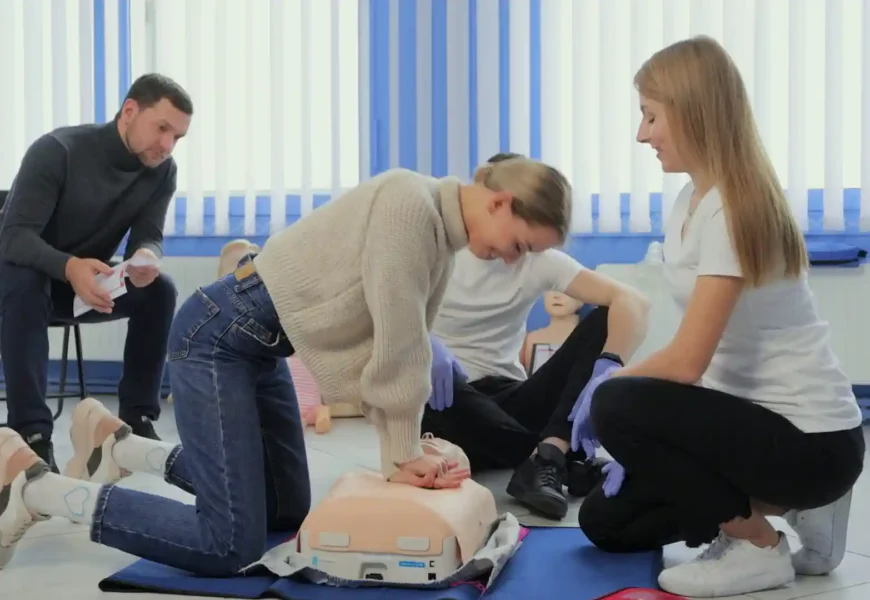Blended First Aid at Work courses combine traditional classroom training with online learning components, offering a flexible and efficient way to deliver comprehensive first aid training. This approach aims to maximize the benefits of both in-person and online education, providing participants with the necessary knowledge and hands-on skills to respond effectively to workplace emergencies. Here’s an overview of what a blended FAW course might involve:
1. Online Learning Modules:
- Theory and Knowledge: Participants complete interactive online modules covering theoretical aspects of first aid. This may include information on legal requirements, basic life support, specific workplace hazards, and more.
- Self-Paced Study: Individuals can progress through the online content at their own pace, allowing for flexibility in learning.
2. In-Person Training Sessions:
- Practical Skills: Participants attend in-person sessions for hands-on training, practicing essential first aid skills under the guidance of qualified instructors.
- Scenario-Based Learning: Simulations and scenarios are conducted to provide a practical understanding of how to respond to real-life workplace emergencies.
- Equipment Use: Participants learn to use first aid equipment, such as automated external defibrillators (AEDs), bandages, and other medical tools.
3. Assessments:
- Online Assessments: Participants may complete quizzes or assessments online to evaluate their understanding of theoretical concepts.
- Practical Assessments: In-person assessments ensure that participants can apply their knowledge and skills in real-life situations.
4. Tailored Content:
- Workplace Relevance: The course may be customized to address specific workplace risks and scenarios, making the training directly applicable to participants’ job environments.
5. Certification:
- Successful Completion: Participants who successfully complete both the online and in-person components receive a certification that is typically valid for a specified duration.
- Legal Compliance: The certification often meets legal requirements for workplace first aid training.
Benefits of Blended FAW Courses:
Blended First Aid at Work courses, which combine both traditional classroom instruction and online learning components, offer several benefits. Here are some advantages of blended FAW courses:
- Flexibility:
- Self-Paced Learning: Participants can access online modules at their own pace, allowing them to review content as needed.
- Convenient Scheduling: Blended courses often provide flexibility in scheduling, making it easier for participants to balance learning with other commitments.
- Accessibility:
- Remote Learning: Online components enable participants to access course materials from anywhere, reducing the need for travel to a physical location.
- 24/7 Availability: Online resources are available 24/7, allowing learners to revisit content and resources at any time.
- Cost-Effectiveness:
- Reduced Travel Costs: Participants can save on transportation and accommodation expenses associated with attending in-person classes.
- Resource Efficiency: Blended courses may require fewer physical resources, such as printed materials, leading to cost savings.
- Individualized Learning:
- Tailored Learning Paths: Online modules can be designed to accommodate various learning styles, allowing participants to engage with the material in ways that suit them best.
- Personalized Feedback: Online assessments and quizzes can provide immediate feedback, helping participants identify areas for improvement.
- Enhanced Engagement:
- Interactive Multimedia: Blended courses often incorporate multimedia elements, such as videos and simulations, to enhance engagement and understanding.
- Discussion Forums: Online platforms may include discussion forums where participants can interact, share experiences, and ask questions.
- Time Efficiency:
- Focused In-Person Sessions: In-person sessions can be reserved for hands-on activities, practical demonstrations, and skills assessments, optimizing the use of face-to-face time.
- Reduced Classroom Hours: Online modules can cover theoretical aspects, allowing in-person sessions to focus on practical application.
- Adaptability:
- Continuous Updates: Online components make it easier to update course content regularly to reflect the latest information and guidelines.
- Customization: Blended courses can be adapted to different learner needs and skill levels.
- Increased Retention:
- Reinforcement: Blended learning allows for the reinforcement of key concepts through both online and in-person activities, improving information retention.
- Varied Instructional Methods: The combination of various instructional methods (online modules, practical exercises, group discussions) caters to different learning preferences.
- Technology Integration:
- Digital Resources: Participants gain experience using technology, which is increasingly important in today’s digital world.
- Online Assessments: Technology allows for efficient and timely assessment of participants’ knowledge and skills.
- Measurable Outcomes:
- Tracking Progress: Online platforms often provide tools for tracking participant progress, allowing instructors and participants to monitor achievements and areas needing improvement.
- Data Analytics: Instructors can use analytics to identify trends, assess the effectiveness of the course, and make data-driven improvements.
Considerations:
- Technology Requirements: Participants need access to an internet connection and suitable devices for online learning.
- Practical Component: While online modules provide knowledge, the practical component is crucial for building hands-on skills and confidence.
Blended FAW courses offer a modern and effective approach to workplace first aid training, catering to the diverse needs and preferences of participants while maintaining the quality and rigor of traditional training methods.










